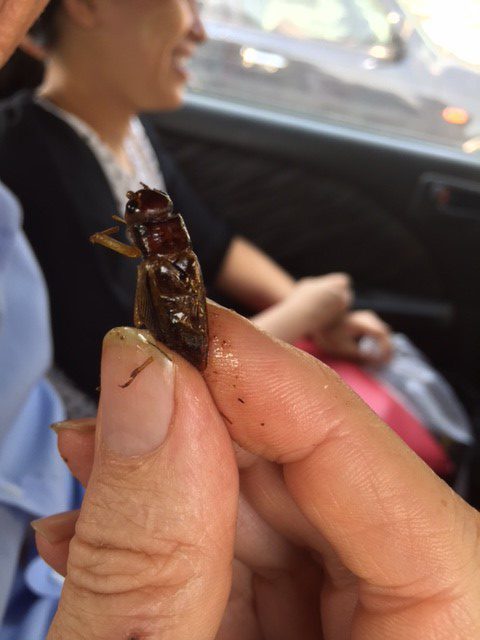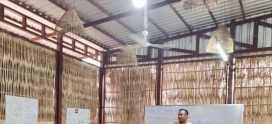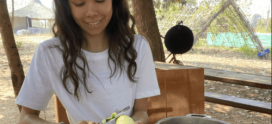Week 7 in Myanmar
Not exactly a Tour-de-France peloton, but the number and permutations of the one-gear bikes, with rickshaws, side-cars, and front and back carriers, is one of the features of Yangon.
The helmeted Lycra-clad version we see bombing around the streets of urban UK would not withstand the obstacles here.
The roads require nothing less than the Full Monty mountain-bike suspension and tyres but the pot-holes are not the major risk; the necessity to spit-out the chewed betel nut through an open door means that too frequently for a rider’s safety the driver’s door opens. Now this wouldn’t be such a problem if the right-hand drive cars drove, as they do in the UK, on the left-hand side of the road. Not a chance; some time after independence from Britain it appears in 1970 by military decree everyone had to suddenly drive on the right. The only motorised vehicles around are old and still right-hand drive; hence the risk of emasculation of the unsuspecting cyclist as he tootles along minding his own business twixt car and curb. Still, there is a happy chaos that exists on all but the best of surfaced roads with cars going around the roundabout the wrong way and driving on both sides of a dual carriageway both ways.
Taxi rides are always with incident; fruit, water, single cigarettes, insects, breads, and a whole host of other edible and inedible objects are delivered to the window interspersed with the occasional taxi driver discharging his bladder in mid trip at the side of the road. Lastly, electricity cuts are a fact of life so stay clear of claustrophobic lifts on the 9th floor (my near miss of the week) as you may be stuck there for hours gradually dying of thirst.
Like so many low/middle income countries of the world which havewitnessed first-hand the ravages of HIV on their communities, there is a lost population of young parents.

Pictured (picture 2) is an orphaned child infected vertically with his grandmother with whom he now lives: healthy, happy with a good CD4. Yesterday I went to listen to a choir of children drawn from the many orphanages in Myanmar, many of whom I’m sure will have HIV. They too looked well and happy: this is a society that takes great care of its lost children and its future.
There are two other pictures: one of a woman weighing 21kg with a CD4 <10, fevers, weight loss, and a history of poor adherence to her HIV and TB meds (picture 3).

Critically unwell, you know there is a limited time frame to interrupt the inevitable progression and this must be done empirically.
The other is of a rash of a lady with penicilliosis, again with a CD4 of under 10 and poor adherence to her 1st line treatment: both these patients came in today (picture 4). Wherever you are in the world it’s the same, patients come to you with problems: here they’re just that bit sicker.

Lopinavir, rifampicin, and itraconazole are the important drugs here that when given together float the pharmacokineticologist’s boat, but it’s a practicing clinicians’ nightmare in Yangon.
On the Saturday, I decided against the 12-hour overnight coach journey somewhere deep in Myanmar, but instead followed the tourist trail around Yangon. Only then do you realise the extent of the previous British colonial occupation. I love old buildings so I was snapping away with my Kodak instamatic both the trademark British architectural excesses and the tall and frequent gold pagodas. Somehow, there is no surface anger against the British (discovered a brewery entitled BurBrit, a joint venture between the Brits and the Burmese) although I was surprised to see that the British Ambassador came from Rangoon and not Yangon on the credits of the orphanage choir evening!
One of the most notable events in the Burmese calendar is upon us next week, the water festival. It marks the Buddhist New Year and is a 4-day brief respite from the burning heat – 44C today. For those of you into serious aquatics, this is a must. From water hoses to pistols, everyone is fair game and everyone gets seriously soaked.
Burmese bareknuckle boxing (or Lethwei) would never pass the UK authorities. Not a topic to describe in detail for the squeamish but a very popular underground Myanmar sport. Kids start training at 8-9 years of age and the purse is not an all or nothing pot (like the heavyweight contests we all detest) but money is thrown into the ring depending on the quality of the contest from each contestant, which only ends when there is a knockout! Not for the feeble bodied but an eye opener as to how boxing in its various formats is one of the most natural competitive sports, unlike cricket which ofcourse, I love. Relevance to HIV and this blog – none, except I suppose there is a real potential for blood-borne virus transmission.
There have been tremendous strides in reducing childhood mortality rates over the last decade in Myanmar but still the under 5 rate is over 100 per 1000 births in certain states. Last week, I met a mother and child where the baby had been infected vertically. Mum had not attended the clinic for some time for her HIV treatment so no peri-natal prophylaxis was given and the baby was breast fed: no wonder the odds started to stack up against the baby. They are now both on ART and hopefully adherence will be good. And that’s where it becomes blindingly obvious: supporting adherence is the key to success or failure for the individual and the community: patient virological control, prevention of resistance, and stopping onward transmission. This is particularly because everyone starts on a fragile combination of EFV, TDF, and 3TC.
So, while everyone else is off to get drenched in the water festival, I’m catching a plane for a couple of weeks back home. No doubt my intestinal flora will readjust again as Shan noodles and tea-leaf salad give way to salmon and apple crumble. Marmite, marmalade, chutney, and unsweetened bread and coffee await me as does the family and my very recently retired lovely doctor wife.
But for those of you who are looking forward to a respite from this diatribe, hard luck. There are skills to master and work to do: maybe even write a research grant. And of course I’ll just have to pour out my soul to the few of you who might read this: even from the UK!




